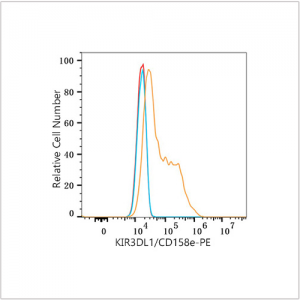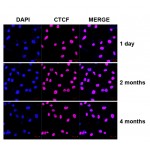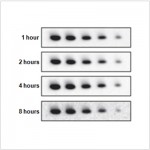PE Rabbit anti-Human KIR3DL1/CD158e mAb (100 T)
| Reactivity: | Human |
| Applications: | FC |
| Host Species: | Rabbit |
| Isotype: | IgG |
| Clonality: | Monoclonal Antibody |
| Conjugation: | PE. Ex:565nm. Em:574nm. |
| Gene Name: | killer cell immunoglobulin like receptor, three Ig domains and long cytoplasmic tail 1 |
| Gene Symbol: | KIR3DL1 |
| Synonyms: | KIR; NKB1; NKAT3; NKB1B; NKAT-3; CD158E1; KIR2DL5B; KIR3DL1/S1 |
| Gene ID: | 3811 |
| UniProt ID: | P43629 |
| Immunogen: | Recombinant fusion protein containing a sequence corresponding to amino acids 22-340 of human KIR3DL1/CD158e (NP_037421.2). |
| Dilution: | FC,5 μl per 10^6 cells in 100 μl volume |
| Purification Method: | Affinity purification |
| Concentration: | 0.02 mg/ml |
| Buffer: | PBS with 0.09% Sodium azide,0.2% BSA, pH7.3. |
| Storage: | Store at -20°C. Avoid freeze / thaw cycles. |
| Documents: | Manual-KIR3DL1 Antibody |
Background
Killer cell immunoglobulin-like receptors (KIRs) are transmembrane glycoproteins expressed by natural killer cells and subsets of T cells. The KIR genes are polymorphic and highly homologous and they are found in a cluster on chromosome 19q13.4 within the 1 Mb leukocyte receptor complex (LRC). The gene content of the KIR gene cluster varies among haplotypes, although several "framework" genes are found in all haplotypes (KIR3DL3, KIR3DP1, KIR3DL4, KIR3DL2). The KIR proteins are classified by the number of extracellular immunoglobulin domains (2D or 3D) and by whether they have a long (L) or short (S) cytoplasmic domain. KIR proteins with the long cytoplasmic domain transduce inhibitory signals upon ligand binding via an immune tyrosine-based inhibitory motif (ITIM), while KIR proteins with the short cytoplasmic domain lack the ITIM motif and instead associate with the TYRO protein tyrosine kinase binding protein to transduce activating signals. The ligands for several KIR proteins are subsets of HLA class I molecules; thus, KIR proteins are thought to play an important role in regulation of the immune response.
Images
 | Flow cytometry: 1×10^6 293T cells (negative control,left) and 293T (Transfection,right) cells were surface-stained with PE Rabbit anti-Human KIR3DL1/CD158e mAb (A26595,5 μl/Test,orange line) or PE Rabbit IgG isotype control (A24172,5 μl/Test,blue line). Non-fluorescently stained cells were used as blank control (red line). |
 | Flow cytometry: 1×10^6 293T (Transfection) cells were surface-stained with PE Rabbit IgG isotype control (A24172,5 μl/Test,left) or PE Rabbit anti-Human KIR3DL1/CD158e mAb (A26595,5 μl/Test,right). |
You may also be interested in:



